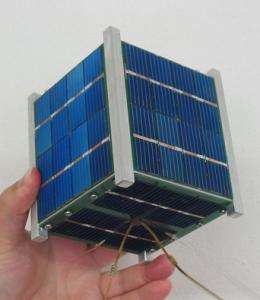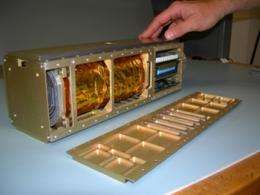Tiny Satellites for Big Science

The shrinking technology of cell phones, laptops and cameras are now leading to palm-sized satellites. Easy to build and affordable, these small satellites offer a new way to conduct astrobiology research. They also could change the way we explore the universe.
When it comes to laptop computers and cell phones, bigger isn’t better. The same logic applies to satellites: the bulkier the satellite, the more time it takes to design and build, and the more expensive it is to put into orbit.
Researchers are now taking advantage of the electronics technologies that have made personal gizmos compact and affordable to make satellites that weigh and cost a fraction of their predecessors. These pocket- and backpack-sized satellites are changing the way astrobiology research is done.
Conventional satellites used for communications, navigation or research can be as large as a school bus and weigh between 100 and 500 kilograms. Universities, companies and NASA are now building small satellites that weigh less than one kilogram (picosatellites) or up to 10 kilograms (nanosatellites).
These small satellites can be considered miniature versions of full-size counterparts. They contain the same components—battery, orbital control and positioning systems, radio communication systems, and analytical instruments—except everything is smaller, less expensive and sometimes less complicated.
“That’s the beauty of this technology,” says Orlando Santos, an astrobiologist at NASA Ames Research Center. “We can make these things small and still get meaningful science out of them.”
The Rise of the Cube
Two decades ago, Bob Twiggs and his students at Stanford University developed the first picosatellite the size of a Klondike ice cream bar. The Aerospace Corporation launched these picosatellites as part of a mission to demonstrate the feasibility of building little satellites that communicate with each other.
Twiggs then worked on CubeSat, a 10-centimeter cube. “I got a 4-inch beanie baby box and tacked on some solar cells to see how many would fit on the surface,” Twiggs says. “I had enough voltage for what I needed so I decided that would be the size.”
Jordi Puig-Suari at California Polytechnic State University built a deployment mechanism called the poly picosatellite orbital deployer, or P-POD, that could pack up to three CubeSats. One of these is typically the satellite bus, the brains of the satellite containing positioning and radio equipment, while the other cubes carry the scientific experiments. In 2004, the researchers sent the first three-cube nanosatellite into orbit.
Six years later, CubeSats have become the world-wide standard for small satellites. They are being used for everything from environmental sensing and fundamental biology research to testing new space flight systems.
Over 60 universities and high schools are part of the CubeSat Project based at Cal Poly. The National Science Foundation and the U.S. Air Force have programs that funds CubeSats for atmospheric and space weather research. Aerospace companies such as Lockheed Martin and Boeing have also built and flown CubeSats.
Kentucky-based NanoRacks LLC provides a platform to take CubeSat experiments as cargo aboard the Space Shuttles to the International Space Station for periods of 30 or 60 days, after which they bring the cubes back.
The goal of NASA’s new CubeSat Launch Initiative is to radically open up the flight opportunities for nanosatellites. This Initiative should also make it easier for universities to compete for launch access on NASA launch vehicles.
There are probably between 35 and 40 small satellites orbiting the Earth right now, of which about a quarter might still be working, says Twiggs, now a professor at Morehead State University’s Space Science Center in Kentucky.
Cutting Costs
The biggest advantage of nano- and pico-satellites is that they are a bargain. Most of the cost saving comes at the launch stage. Unlike conventional satellites, they don’t need a dedicated launch vehicle where they are the primary payload. “They’re so small they can hitch a ride on somebody else’s rocket,” Santos says. NASA’s nanosatellite missions cost two million a piece as opposed to the tens of millions needed for a conventional satellite.
Their affordability also comes from being built with off-the-shelf electronic circuit chips such as microprocessors and radio frequency transmitters and receivers. These are the same components that are inside smart phones, hand-held Global Positioning System units, and digital cameras.
In fact, the miniaturization of electronics has been the driving force behind small satellite technology, making it affordable, says Twiggs. “Electronics today are much more power-efficient than electronics of the past; that helps us,” he says. “Ten or fifteen years ago we couldn’t have found the components for the price that we could’ve afforded.”
Small satellites shouldn’t add to the problem of space debris since they are relatively easy to deorbit. NASA’s Astrobiology Science and Technology Instrument Development has an upcoming nanosatellite mission, Organism/Organic Exposure to Orbital Stresses (O/OREOS). O/OREOS will have a sail packed into it that will be deployed at the end of the mission. “It increases the satellite’s surface area and speeds up its fall to Earth,” Santos says. “It’s so small it’ll burn up soon as it enters the atmosphere.”
The low cost and relatively quick turnaround time of a few months makes nanosatellites invaluable from an education perspective. Students and young engineers get to participate in a project from the initial paper design to building and testing to the eventual launch. This gives next-generation scientists hands-on experience in development, management and mission training.

Astrobiology in Miniature
For NASA, low-cost nanosatellites are an ideal platform for science and technology, including fundamental biology and astrobiology research.
“Astrobiology is ripe for the use of small satellites,” says Jason Crusan, chief technologist for space operations at NASA headquarters in Washington, D.C. Performing a large number of experiments is best for studying biological processes. “If you can increase your flight frequency then you increase the number of experiments you need to do, but you need a lower-cost solution like nanosatellites to do this.”
Besides, unlike astronomy, experiments for astrobiology lend themselves to miniaturization. This is due to advances in microfluidics technologies and the miniaturization of optical detection instruments. For instance, the spectrometer on O/OREOS is the size of a candy bar.
Santos says that there is an intense interest in astrobiology and life sciences to gain access to interplanetary conditions above low-Earth orbit. That’s where you can study how living organisms and life-related compounds are affected by the cosmic radiation above the Earth’s protective atmosphere and by reduced gravity. “That’s how we can study the big questions in astrobiology,” he says. “What happens when we go to space? Or are we carrying microorganisms that may contaminate science experiments?”
So far, NASA has launched two nanosatellites into low-Earth orbit between 450 and 550 kilometers above the surface. GeneSat, which was launched in December 2006, studied the effects of space on bacteria, while PharmaSat, which went up in May 2009, investigated the effects of antifungal agents on yeast growth in space. The O/OREOS satellite, which will be launched late this year into 650-kilometer orbit, will study the effects of a larger array of space conditions on microbes and important biological compounds.
In the future, nanosatellites may allow experiments to reach beyond low-Earth orbit. They could go into lunar orbit or into solar orbit halfway between the Earth and Venus, or one day even land on the moon. Envoys of CubeSats that have more smarts and a built-in thrust mechanism might even be sent out to explore vast swaths of our solar system and beyond. Orbiting other planets or landing on the surface, these nano-explorers could search for compounds that signal the existence of life, communicating their findings with each other and with controllers on Earth.
Twiggs is now working with researchers at the University of Rome on pocket-sized 5-centimeter cubes. Because these are an eighth of the volume of regular CubeSats, Twiggs hopes they will cost that much less. The team is planning to launch eight of these pocket cubes packed inside a launcher on a Russian ballistic missile by spring of 2011.
Nano- and picosatellites will not replace their larger cousins—there are certain experiments that cannot be miniaturized or that need more power and hence more area for solar panels and antennae.
“Everybody doesn’t drive a little teeny car, there are big trucks to carry things around,” Twiggs says. Instead, small satellites should open up a new way to do research and education, proving that good things can come in small packages.
Provided by Astrobio.net




















